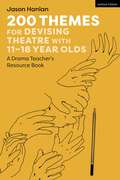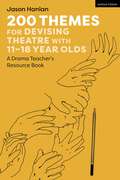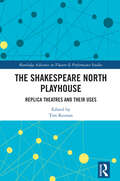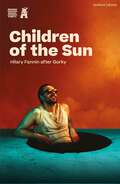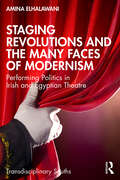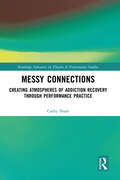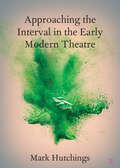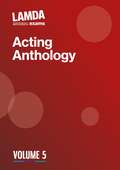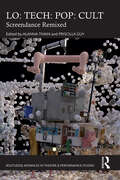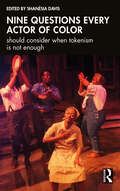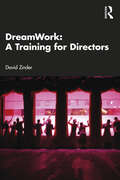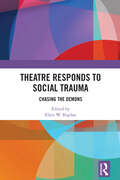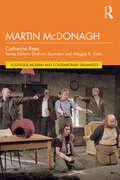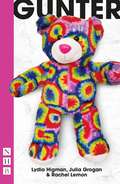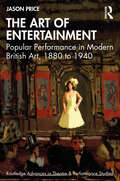- Table View
- List View
200 Themes for Devising Theatre with 11–18 Year Olds: A Drama Teacher’s Resource Book
by Jason HanlanA unique resource for drama teachers providing 200 stimuli and age-appropriate individual topics within those to help inspire and guide young people in devising performance. It contains useful information on devising techniques, workshops, schemes and lesson ideas for introducing devising and guidance on how to analyse the work and give feedback.Following on from his successful book 200 Plays for GCSE and A-Level Performance, author Jason Hanlan has once again solved one of drama teachers' most frequently encountered problems: how to unlock the best devised performance with their students.Devising as a group requires a level of collaboration, which - without a strong framework - often descends into wild flights of fancy and a myriad of dead ends. Excellent ideas can be lost or diluted in an often-awkward attempt to tie it all together to fit a narrative.The main body of this book is a unique numbered listing of 200 stimuli, designed to both inspire and focus the mind, with an example of a possible topic and 'ways in' that would be suitable for each level:"Civil rights"> "Votes for women" (11 - 14 year olds)> "Rosa Parks" (14-16 year olds)> "The Disappeared" (16 - 18 year olds)Each stimuli is given its own page dedicated to exploring its possibilities as a piece of devised theatre for different age groups, and offering suggestions for plays, films and books to look at; artefacts and images to examine; ideas to consider; and further research you can draw on.
200 Themes for Devising Theatre with 11–18 Year Olds: A Drama Teacher’s Resource Book
by Jason HanlanA unique resource for drama teachers providing 200 stimuli and age-appropriate individual topics within those to help inspire and guide young people in devising performance. It contains useful information on devising techniques, workshops, schemes and lesson ideas for introducing devising and guidance on how to analyse the work and give feedback.Following on from his successful book 200 Plays for GCSE and A-Level Performance, author Jason Hanlan has once again solved one of drama teachers' most frequently encountered problems: how to unlock the best devised performance with their students.Devising as a group requires a level of collaboration, which - without a strong framework - often descends into wild flights of fancy and a myriad of dead ends. Excellent ideas can be lost or diluted in an often-awkward attempt to tie it all together to fit a narrative.The main body of this book is a unique numbered listing of 200 stimuli, designed to both inspire and focus the mind, with an example of a possible topic and 'ways in' that would be suitable for each level:"Civil rights"> "Votes for women" (11 - 14 year olds)> "Rosa Parks" (14-16 year olds)> "The Disappeared" (16 - 18 year olds)Each stimuli is given its own page dedicated to exploring its possibilities as a piece of devised theatre for different age groups, and offering suggestions for plays, films and books to look at; artefacts and images to examine; ideas to consider; and further research you can draw on.
The Shakespeare North Playhouse: Replica Theatres and Their Uses (ISSN)
by Tim KeenanThis collection celebrates the opening of the Shakespeare North Playhouse (SNP). After discussion of its genesis and development by four people pivotal to its progress at different stages of the project, this book explores different aspects of the SNP’s purpose and functions across three broad categories: buildings and spaces, practices and performance, and community arts and education. Various chapters offer answers to fundamental questions about replica theatres, including: Why do we build them? What do they do? How do we use them? In the course of these discussions, the purposes, potential, and programming of the SNP are discussed in relation to other Globe-type replicas in the UK and beyond. Contributors to this collection analyse key academic and practice-based concerns within their fields of expertise connected to the use (and misuse) of replica theatres to suggest the ways in which they can be used to drive research and practice in contemporary Shakespearean performance, connect with young people, and serve local communities.This book will appeal to academics, students, and practitioners interested in historical and contemporary approaches to Shakespeare in the fields covered. It should also appeal to general readers with an interest in the topics, particularly in Merseyside and the North-West region.
The Shakespeare North Playhouse: Replica Theatres and Their Uses (ISSN)
This collection celebrates the opening of the Shakespeare North Playhouse (SNP). After discussion of its genesis and development by four people pivotal to its progress at different stages of the project, this book explores different aspects of the SNP’s purpose and functions across three broad categories: buildings and spaces, practices and performance, and community arts and education. Various chapters offer answers to fundamental questions about replica theatres, including: Why do we build them? What do they do? How do we use them? In the course of these discussions, the purposes, potential, and programming of the SNP are discussed in relation to other Globe-type replicas in the UK and beyond. Contributors to this collection analyse key academic and practice-based concerns within their fields of expertise connected to the use (and misuse) of replica theatres to suggest the ways in which they can be used to drive research and practice in contemporary Shakespearean performance, connect with young people, and serve local communities.This book will appeal to academics, students, and practitioners interested in historical and contemporary approaches to Shakespeare in the fields covered. It should also appeal to general readers with an interest in the topics, particularly in Merseyside and the North-West region.
Children of the Sun (Modern Plays)
by Ms. Hilary Fannin Maxim GorkyI am attempting to colonise the last frontier. Time, Elena, time. If we could inhabit different iterations of self, we could undo all the mistakes of the past. Don't you see?Hilary Fannin's radical adaptation of Maxim Gorky's classic 1905 dark comedy reworks the original text and draws it into the here and now. Children of the Sun is the story of a small family and their quixotic collection of acquaintances, entertaining and enraging each other while, unseen beyond their fragile walls, their world is being reshaped by unstoppable forces. The play asks how we survive without the benefit of hindsight and whether science, art or love are capable of saving us from uncertainty and destruction. Co-produced by Rough Magic and the Abbey Theatre, Children of the Sun premiered on the Abbey stage as part of Rough Magic's 40th-anniversary year in April 2024. This edition was published to coincide with that production.
Children of the Sun (Modern Plays)
by Ms. Hilary Fannin Maxim GorkyI am attempting to colonise the last frontier. Time, Elena, time. If we could inhabit different iterations of self, we could undo all the mistakes of the past. Don't you see?Hilary Fannin's radical adaptation of Maxim Gorky's classic 1905 dark comedy reworks the original text and draws it into the here and now. Children of the Sun is the story of a small family and their quixotic collection of acquaintances, entertaining and enraging each other while, unseen beyond their fragile walls, their world is being reshaped by unstoppable forces. The play asks how we survive without the benefit of hindsight and whether science, art or love are capable of saving us from uncertainty and destruction. Co-produced by Rough Magic and the Abbey Theatre, Children of the Sun premiered on the Abbey stage as part of Rough Magic's 40th-anniversary year in April 2024. This edition was published to coincide with that production.
Staging Revolutions and the Many Faces of Modernism: Performing Politics in Irish and Egyptian Theatre (Transdisciplinary Souths)
by Amina ElHalawaniThe book explores how theatre, with its performative capacity, has the power to engage with and affect the politics of its day. It sets the stage for the reader to discover the revolutionary traditions of Egyptian and Irish theatre, very distinct in their histories and cultures, and understand their enduring relevance in today’s world. The volume takes Ireland as a case study of the interplay between cultural nationalism and politically engaged theatre and compares it to the role of the theatre in Egypt during its Golden era in the 1960s.Through a selection of Egyptian plays by Tawfiq al-Hakim, Mikhail Roman, Yusuf Idris, and Salah Abdul-Saboor, alongside Irish plays by Brian Friel, Frank McGuinness, Christina Reid, and Samuel Beckett, it maps the political aesthetics of unsteady times and seemingly disparate places to reflect on the dynamics of revolt as a staged act in and of itself. Further, the book examines how playwrights from both nations have engaged with theatre as a medium, focusing on how their contemplations, hesitations, frustrations, and protest have been translated onto the stage in their various plays, and comprehends the transformative role the theatre has always played in politics in shaping history across time and space.Bridging together discussions on transnational modernisms with nuanced cultural histories of protest, this critical work will be of great interest to scholars and researchers of literary studies, identity politics, cultural studies, theatre and performance studies, and political studies.
Staging Revolutions and the Many Faces of Modernism: Performing Politics in Irish and Egyptian Theatre (Transdisciplinary Souths)
by Amina ElHalawaniThe book explores how theatre, with its performative capacity, has the power to engage with and affect the politics of its day. It sets the stage for the reader to discover the revolutionary traditions of Egyptian and Irish theatre, very distinct in their histories and cultures, and understand their enduring relevance in today’s world. The volume takes Ireland as a case study of the interplay between cultural nationalism and politically engaged theatre and compares it to the role of the theatre in Egypt during its Golden era in the 1960s.Through a selection of Egyptian plays by Tawfiq al-Hakim, Mikhail Roman, Yusuf Idris, and Salah Abdul-Saboor, alongside Irish plays by Brian Friel, Frank McGuinness, Christina Reid, and Samuel Beckett, it maps the political aesthetics of unsteady times and seemingly disparate places to reflect on the dynamics of revolt as a staged act in and of itself. Further, the book examines how playwrights from both nations have engaged with theatre as a medium, focusing on how their contemplations, hesitations, frustrations, and protest have been translated onto the stage in their various plays, and comprehends the transformative role the theatre has always played in politics in shaping history across time and space.Bridging together discussions on transnational modernisms with nuanced cultural histories of protest, this critical work will be of great interest to scholars and researchers of literary studies, identity politics, cultural studies, theatre and performance studies, and political studies.
Messy Connections: Creating Atmospheres of Addiction Recovery Through Performance Practice (ISSN)
by Cathy SloanThis book examines performance practices that involve people in recovery from addiction, theorising such practices as recovery-engaged.Focusing on examples of practice from a growing movement of UK-based recovery arts practitioners and performers, it highlights a unique approach to performance that infuses an understanding of lived experiences of addiction and recovery with creative practice. It offers a philosophy of being in recovery that understands lived experience, and performance practice, as a dynamic system of interrelations with the human and nonhuman elements that make up the societal settings in which recovery communities struggle to exist. It thereby frames the process of recovery, and recovery-engaged performance, as an affective ecology – a system of messy connections. Building upon ideas from posthumanist research on addiction, cultural theory on identity and new materialist interpretations of performance practice, it considers how such contemporary theory might offer additional ways of thinking and doing arts practice with people affected by addiction. The discussion highlights the distinct aesthetics, ethics and politics of this area of performance practice.This study will be of great interest to students and scholars in Applied Theatre and Critical Arts and Mental Health studies.
Messy Connections: Creating Atmospheres of Addiction Recovery Through Performance Practice (ISSN)
by Cathy SloanThis book examines performance practices that involve people in recovery from addiction, theorising such practices as recovery-engaged.Focusing on examples of practice from a growing movement of UK-based recovery arts practitioners and performers, it highlights a unique approach to performance that infuses an understanding of lived experiences of addiction and recovery with creative practice. It offers a philosophy of being in recovery that understands lived experience, and performance practice, as a dynamic system of interrelations with the human and nonhuman elements that make up the societal settings in which recovery communities struggle to exist. It thereby frames the process of recovery, and recovery-engaged performance, as an affective ecology – a system of messy connections. Building upon ideas from posthumanist research on addiction, cultural theory on identity and new materialist interpretations of performance practice, it considers how such contemporary theory might offer additional ways of thinking and doing arts practice with people affected by addiction. The discussion highlights the distinct aesthetics, ethics and politics of this area of performance practice.This study will be of great interest to students and scholars in Applied Theatre and Critical Arts and Mental Health studies.
Approaching the Interval in the Early Modern Theatre: The Significance of the 'Act-Time' (Elements in Shakespeare Performance)
by null Mark HutchingsIn requiring artificial light, the early modern indoor theatre had to interrupt the action so that the candles could be attended to, if necessary. The origin of the five-act, four-interval play was not classical drama but candle technology. This Element explores the implications of this aspect of playmaking. Drawing on evidence in surviving texts it explores how the interval affected composition and stagecraft, how it provided opportunities for stage-sitters, and how amphitheatre plays were converted for indoor performance (and vice versa). Recovering the interval yields new insights into familiar texts and brings into the foreground interesting examples of how the interval functioned in lesser-known plays. This Element concludes with a discussion of how this aspect of theatre might feed into the debate over the King's Men's repertory management in its Globe-Blackfriars years and sets out the wider implications for both the modern theatre and the academy.
LAMDA Acting Anthology: Volume 5
by Lamda ExamsThis anthology presents the set selection of solo and duologue scenes for Learners entering LAMDA Graded Examinations in Performance: Acting from Grade 1 to Grade 5. The 100 speeches and scenes in this collection include excerpts from published plays and adapted novels, as well as new, original material written specifically for this anthology. There are monologues for solo performance and duologue scenes for two performers, all carefully curated to offer a broad range of material written by a variety of acclaimed playwrights, from Euripides, Shakespeare and Ibsen to Caryl Churchill, Chinonyerem Odimba and Jack Thorne. Also included is a foreword by actor and LAMDA graduate Ruth Wilson. For Learners taking LAMDA Examinations, this anthology offers a wide choice of characters and worlds to explore. There is material for younger candidates who are just entering the world of performance, as well as material for older, more experienced actors. For the general reader, this anthology is an ideal starting point for discovering the work of contemporary playwrights, as well as reconnecting with celebrated writers of the past.
LO: Screendance Remixed (ISSN)
by Alanna Thain Priscilla GuyThis edited collection assembles international perspectives from artists, academics, and curators in the field to bring the insights of screendance theory and practice back into conversations with critical methods, at the intersections of popular culture, low-tech media practices, dance, and movement studies, and the minoritarian perspectives of feminism, queer theory, critical race studies and more.This book represents new vectors in screendance studies, featuring contributions by both artists and theoreticians, some of the most established voices in the field as well as the next generation of emerging scholars, artists, and curators. It builds on the foundational cartographies of screendance studies that attempted to sketch out what was particular to this practice. Sampling and reworking established forms of inquiry, artistic practice and spectatorial habits, and suspending and reorienting gestures into minoritarian forms, these conversations consider the affordances of screendance for reimaging the relations of bodies, technologies, and media today.This collection will be of great interest to students and scholars in dance studies, performance studies, cinema and media studies, feminist studies, and cultural studies.
LO: Screendance Remixed (ISSN)
This edited collection assembles international perspectives from artists, academics, and curators in the field to bring the insights of screendance theory and practice back into conversations with critical methods, at the intersections of popular culture, low-tech media practices, dance, and movement studies, and the minoritarian perspectives of feminism, queer theory, critical race studies and more.This book represents new vectors in screendance studies, featuring contributions by both artists and theoreticians, some of the most established voices in the field as well as the next generation of emerging scholars, artists, and curators. It builds on the foundational cartographies of screendance studies that attempted to sketch out what was particular to this practice. Sampling and reworking established forms of inquiry, artistic practice and spectatorial habits, and suspending and reorienting gestures into minoritarian forms, these conversations consider the affordances of screendance for reimaging the relations of bodies, technologies, and media today.This collection will be of great interest to students and scholars in dance studies, performance studies, cinema and media studies, feminist studies, and cultural studies.
Nine questions every actor of color should consider when tokenism is not enough
This book confronts and analyzes the systemic racism that confronts actors of color in the USA through interviews with leading performers in the nation’s theatrical epicentre of Chicago.Each chapter deals with a different central question, from how these actors approach roles and the obstacles that they face, to the ways in which the industry can change to better enable actors of color. By bringing together these actors and sharing the ways in which they have functioned within the white theatre world, we can appreciate how theatre needs to embrace their identities so that all voices are heard, understood, and valued. The stories of these actors will reflect the systemic racism of the past and present with the hope of remaking the future.This is an important book for students, teachers, and professionals who engage in theatre work, helping them to understand the lived experiences of actors of color through those actors’ own words.
Nine questions every actor of color should consider when tokenism is not enough
by Shanésia DavisThis book confronts and analyzes the systemic racism that confronts actors of color in the USA through interviews with leading performers in the nation’s theatrical epicentre of Chicago.Each chapter deals with a different central question, from how these actors approach roles and the obstacles that they face, to the ways in which the industry can change to better enable actors of color. By bringing together these actors and sharing the ways in which they have functioned within the white theatre world, we can appreciate how theatre needs to embrace their identities so that all voices are heard, understood, and valued. The stories of these actors will reflect the systemic racism of the past and present with the hope of remaking the future.This is an important book for students, teachers, and professionals who engage in theatre work, helping them to understand the lived experiences of actors of color through those actors’ own words.
DreamWork: A Training for Directors
by David ZinderDreamWork: A Training for Directors provides a theoretical basis and a highly detailed, practical, step-by-step blueprint for developing a directorial concept for a play.Directing is a complex, multi-staged artistic process which, for the most part, is a collaborative work of art. The director works with designers, composers, choreographers and actors to create the performance that is eventually shown to an audience. In this process, there is one stage of the director’s work which is uniquely personal and individual: the creation of a directorial concept. This book concentrates on this crucial stage of the director’s work, offering a template for the creation of a directorial concept prior to embarking on the collaborative stage of the director’s work. The book follows the process from the choice of the text, through a series of clearly documented and structured sets of strategies with attendant examples, up to the creation of the director’s version of the original play - the adaptation - that is the starting point for the director’s dialogue with designers, composers, choreographers and actors.DreamWork: A Training for Directors is intended for directing students at universities or theatre academies, both at undergraduate and graduate levels, as well as directors at the beginning of their careers.
DreamWork: A Training for Directors
by David ZinderDreamWork: A Training for Directors provides a theoretical basis and a highly detailed, practical, step-by-step blueprint for developing a directorial concept for a play.Directing is a complex, multi-staged artistic process which, for the most part, is a collaborative work of art. The director works with designers, composers, choreographers and actors to create the performance that is eventually shown to an audience. In this process, there is one stage of the director’s work which is uniquely personal and individual: the creation of a directorial concept. This book concentrates on this crucial stage of the director’s work, offering a template for the creation of a directorial concept prior to embarking on the collaborative stage of the director’s work. The book follows the process from the choice of the text, through a series of clearly documented and structured sets of strategies with attendant examples, up to the creation of the director’s version of the original play - the adaptation - that is the starting point for the director’s dialogue with designers, composers, choreographers and actors.DreamWork: A Training for Directors is intended for directing students at universities or theatre academies, both at undergraduate and graduate levels, as well as directors at the beginning of their careers.
Theatre Responds to Social Trauma: Chasing the Demons (Routledge Series in Equity, Diversity, and Inclusion in Theatre and Performance)
by Ellen W. KaplanThis book is a collection of chapters by playwrights, directors, devisers, scholars, and educators whose praxis involves representing, theorizing, and performing social trauma.Chapters explore how psychic catastrophes and ruptures are often embedded in social systems of oppression and forged in zones of conflict within and across national borders. Through multiple lenses and diverse approaches, the authors examine the connections between collective trauma, social identity, and personal struggle. We look at the generational transmission of trauma, socially induced pathologies, and societal re-inscriptions of trauma, from mass incarceration to war-induced psychoses, from gendered violence through racist practices. Collective trauma may shape, protect, and preserve group identity, promoting a sense of cohesion and meaning, even as it shakes individuals through pain. Engaging with communities under significant stress through artistic practice offers a path towards reconstructing the meaning(s) of social trauma, making sense of the past, understanding the present, and re-visioning the future.The chapters combine theoretical and practical work, exploring the conceptual foundations and the artists’ processes as they interrogate the intersections of personal grief and communal mourning, through drama, poetry, and embodied performance.
Theatre Responds to Social Trauma: Chasing the Demons (Routledge Series in Equity, Diversity, and Inclusion in Theatre and Performance)
This book is a collection of chapters by playwrights, directors, devisers, scholars, and educators whose praxis involves representing, theorizing, and performing social trauma.Chapters explore how psychic catastrophes and ruptures are often embedded in social systems of oppression and forged in zones of conflict within and across national borders. Through multiple lenses and diverse approaches, the authors examine the connections between collective trauma, social identity, and personal struggle. We look at the generational transmission of trauma, socially induced pathologies, and societal re-inscriptions of trauma, from mass incarceration to war-induced psychoses, from gendered violence through racist practices. Collective trauma may shape, protect, and preserve group identity, promoting a sense of cohesion and meaning, even as it shakes individuals through pain. Engaging with communities under significant stress through artistic practice offers a path towards reconstructing the meaning(s) of social trauma, making sense of the past, understanding the present, and re-visioning the future.The chapters combine theoretical and practical work, exploring the conceptual foundations and the artists’ processes as they interrogate the intersections of personal grief and communal mourning, through drama, poetry, and embodied performance.
Martin McDonagh (Routledge Modern and Contemporary Dramatists)
by Catherine ReesThis comprehensive, accessible introduction to one of Britain’s leading contemporary playwrights and filmmakers outlines Martin McDonagh’s body of work, the key critical contexts for understanding and exploring his career, analysis of productions, and includes an exclusive interview with the director of his most recent stage work. Analysis of McDonagh’s writing is broken down into three periods – his early Irish plays, his screenplays, and his later plays that move away from and outside of Ireland. Works are discussed thematically, giving a dynamic reading of the scripts and the ideas around which they circle. The book’s final section then delves in more detail into selected seminal productions of McDonagh’s writing, outlining key phases and transitions in his career.Part of the Routledge Modern and Contemporary Dramatists series, Martin McDonagh is an essential guide for scholars and students who are setting out to understand the life and work of one of the most popular and acclaimed British dramatists and filmmakers of the twenty-first century.
Martin McDonagh (Routledge Modern and Contemporary Dramatists)
by Catherine ReesThis comprehensive, accessible introduction to one of Britain’s leading contemporary playwrights and filmmakers outlines Martin McDonagh’s body of work, the key critical contexts for understanding and exploring his career, analysis of productions, and includes an exclusive interview with the director of his most recent stage work. Analysis of McDonagh’s writing is broken down into three periods – his early Irish plays, his screenplays, and his later plays that move away from and outside of Ireland. Works are discussed thematically, giving a dynamic reading of the scripts and the ideas around which they circle. The book’s final section then delves in more detail into selected seminal productions of McDonagh’s writing, outlining key phases and transitions in his career.Part of the Routledge Modern and Contemporary Dramatists series, Martin McDonagh is an essential guide for scholars and students who are setting out to understand the life and work of one of the most popular and acclaimed British dramatists and filmmakers of the twenty-first century.
Gunter (Nhb Modern Plays Ser.)
by Lydia Higman Rachel Lemon Julia Grogan1604. A small village outside Oxford. Two boys have been murdered by local brute Brian Gunter at a football match and their mum wants justice. But Brian is also the richest and most powerful man in the village, and has an ego too fragile to tolerate public slander… A nasty feud begins, and when Brian's daughter Anne starts demonstrating strange afflictions, an allegation is made: she has been bewitched. Impassioned and highly theatrical, Dirty Hare's award-winning production of Gunter, co-created by Lydia Higman, Julia Grogan and Rachel Lemon, tells a true story of deception, witchcraft and football. The play premiered at Summerhall at the Edinburgh Festival Fringe in 2023, where it was awarded a Scotsman Fringe First Award, Pick of the Fringe from both Playbill and Lyn Gardner, whilst Dirty Hare were named one of The Stage's Fringe Five list of breakout theatremakers. It transferred to the Royal Court Theatre, London, in 2024. 'An incantation, working dark magic into a small room' - Financial Times 'Atmospheric retelling of a famous witch trial… there's a sensuousness to the storytelling… appealingly energetic' - The Stage 'Electrifying… equally intense and playful' - Playbill
The Art of Entertainment: Popular Performance in Modern British Art, 1880 to 1940 (ISSN)
by Jason PriceIn this book, theatre historian Jason Price looks at the relationships and exchanges that took place between high and low cultural forms in Britain from 1880 to 1940, focusing on the ways in which figures from popular entertainments, such as music hall serio-comics, clowns, and circus acrobats, came to feature in modern works of art.Readers with an interest in art, theatre, and the history of modern Britain will find Price’s approach, which sees major works of art used to illuminate the histories of once-famous entertainers and the wider social, political, and cultural landscape of this period, accessible and engaging. The book will bring to life for readers some of the most vivid works of modern British art and reveal how individuals historically overlooked due to their gender, sexuality, or race played a significant role in the shaping of British culture during this period of monumental social change.
The Art of Entertainment: Popular Performance in Modern British Art, 1880 to 1940 (ISSN)
by Jason PriceIn this book, theatre historian Jason Price looks at the relationships and exchanges that took place between high and low cultural forms in Britain from 1880 to 1940, focusing on the ways in which figures from popular entertainments, such as music hall serio-comics, clowns, and circus acrobats, came to feature in modern works of art.Readers with an interest in art, theatre, and the history of modern Britain will find Price’s approach, which sees major works of art used to illuminate the histories of once-famous entertainers and the wider social, political, and cultural landscape of this period, accessible and engaging. The book will bring to life for readers some of the most vivid works of modern British art and reveal how individuals historically overlooked due to their gender, sexuality, or race played a significant role in the shaping of British culture during this period of monumental social change.
